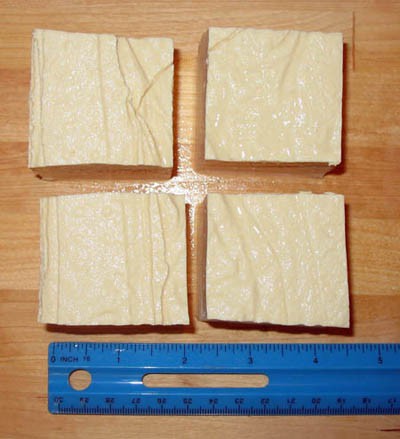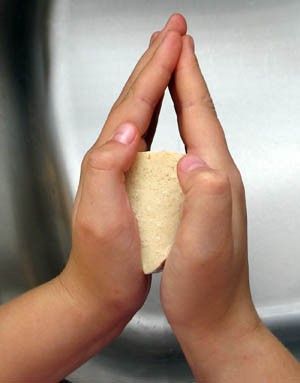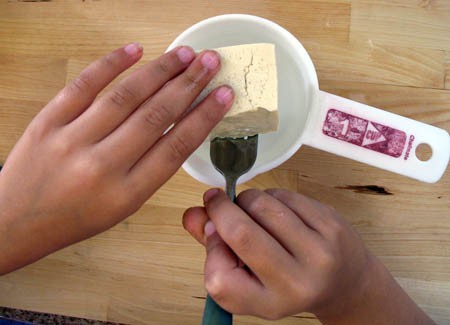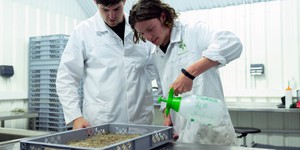Abstract
Spicy fried tofu. It's a delicious and savory main dish at many Asian restaurants. Stab a golden-brown piece, bite into it, and the juice inside rushes out, filling your mouth with rich flavors. Continue eating and you find the texture is very chewy and meat-like. Did you ever wonder how those white blocks of tofu you see in grocery stores are transformed into the chewy little sponges packed with flavorful juices you see in Asian restaurants? Try this cooking and food science fair project to find out!Summary
Kristin Strong, Science Buddies

Objective
To determine if freezing can produce sponge-like qualities in tofu.
Introduction
Freezer burn! Limp vegetables! Ice crystals! Dried-out meats! Discoloration! Off-flavors! Although freezing is one of the most effective ways to preserve foods, it is also one of the most traumatic methods of preservation. That's because many foods contain water, and as that water freezes, it crystallizes and expands, breaking the cell walls of animal and plant tissues. Because the cells walls are no longer intact, their contents are then free to leak out after thawing, leaving produce floppy and meats drier and tougher than normal. Food scientists have learned tricks for minimizing the trauma of freezing, like using fast, "deep freezing," which produces smaller, less damaging ice crystals than slow, high-temperature freezing.
There is a notable exception, though, to this general notion that freezing degrades the physical properties of foods, and that is soybean curd, also known as tofu. Tofu is much like cheese in that it is the curdled product of a liquid protein source. Cheese comes from milk that is curdled with bacteria. The bacteria produce an acid, which reacts with the protein in the milk. However, tofu comes from soymilk that is curdled with calcium or magnesium salts that react with the protein in the soymilk. During the reaction, coagulation occurs, and the proteins clump together to form curds. Freezing benefits tofu because as ice crystals grow inside it, they press and concentrate the coagulated proteins, making them stronger. Then, when the tofu is thawed and the water from the ice crystals drains away, pockets of air are left among a strong, coagulated protein network. A soybean sponge is born! One that can absorb all sorts of tasty juices and sauces.
In this cooking and food science fair project, you will investigate how the color, texture, physical structure, and absorption of tofu changes when it is frozen. You will compare the ability of fresh, unfrozen tofu to absorb a liquid against the ability of frozen, and then thawed tofu to absorb a liquid. You will also watch out for color, texture, structure, and even sound changes. So, let's go see how much slurping your tofu sponge can do!
Terms and Concepts
- Freezer burn
- Ice crystal
- Discoloration
- Preserve
- Trauma
- Crystallize
- Tissue
- Curd
- Tofu
- Curdle
- Protein
- Bacteria
- Acid
- Calcium
- Magnesium salt
- Coagulation
- Concentration
- Absorption
- Compress
Questions
- What happens to food when it is frozen?
- How can the trauma of freezing be reduced?
- How is tofu made?
Bibliography
- McGee, Harold. On Food and Cooking: The Science and Lore of the Kitchen. New York: Scribner, 2004. pp. 18-19, 24, 146-147, 206, 277-278, 495-496.
This source describes freezer burn:
- Everyday Mysteries Contributors. (2007, March 1). What is "freezer burn"?. Retrieved October 9, 2008.
Materials and Equipment
- Tofu, extra-firm (2 packages)
- Ruler
- Knife
- Cutting board
- Large airtight containers (2)
- Dry measuring cups
- Small pitcher or liquid measuring cup
- Fork
- Timer or watch with a second hand
- Graduated cylinders, 250-mL size (2); available at Amazon.com.
- Refrigerator and freezer
- Magnifying glass or Jakks EyeClops Bionic Eye, available at Amazon.com.
- Lab notebook
Disclaimer: Science Buddies participates in affiliate programs with Home Science Tools, Amazon.com, Carolina Biological, and Jameco Electronics. Proceeds from the affiliate programs help support Science Buddies, a 501(c)(3) public charity, and keep our resources free for everyone. Our top priority is student learning. If you have any comments (positive or negative) related to purchases you've made for science projects from recommendations on our site, please let us know. Write to us at scibuddy@sciencebuddies.org.
Experimental Procedure
Preparing Your Tofu Cubes
- Open the first package of extra-firm tofu and pour off the water inside. Make sure you are using extra-firm tofu for your trials since it is the easiest style of tofu to handle and cut up.
- Place your block of tofu on a cutting board and, using a ruler and a knife, cut it into four equal cubes, approximately 1½-2½ inches long and 1½-2½ inches wide. If the block of tofu is fairly level, the height should be approximately the same for all cubes; otherwise, trim off any excess height to make it level. Make sure the cubes can fit inside your 1-cup dry measuring cup.
 Image Credit: Kristin Strong, Science Buddies / Science Buddies
Image Credit: Kristin Strong, Science Buddies / Science Buddies
Figure 1. This photo shows one block of tofu cut into four equal cubes.
- Repeat step 2 for the second block of tofu.
- Place three of the cubes in an airtight container, large enough so that the cubes do not touch each other. Seal the lid and place the container in the freezer for at least two days.
- Soon after you've placed the other cubes in the freezer, place the other three cubes in an airtight container, cover the tofu with tap water, seal the lid, and place the container in the refrigerator for at least 3-4 days. Change the water in the container every 24 hours, so that it stays fresh, until you are ready to begin testing.
- Note: Plan ahead because your freezer tofu will need time to thaw before testing. 1-2 days before you want to begin testing, take the container of frozen tofu cubes out of the freezer and place it in the refrigerator to thaw. Continue changing the water in the refrigerated container as the frozen tofu thaws.
Testing Your Tofu Cubes
- Remove all the tofu cubes from their containers, but make sure you keep them separated so you know which came from the freezer and which came from the refrigerator. Look at the cubes and compare the ones that were previously frozen with the ones that were never frozen. What differences do you see? If the cubes were to be all mixed up, would you be able to tell which ones had never been frozen and which ones had previously been frozen? Write down your observations in your lab notebook.
- Gently, but firmly, squeeze one tofu cube that was never frozen over a sink. Then do the same for a tofu cube that was previously frozen, as shown in Figure 2. What differences do you notice? Think about the way each tofu cube feels, how far you can compress (squeeze down) each one, and the sound each one makes. Set aside the cubes after you've compressed them, remembering which one was frozen and which was never frozen. Write down your observations in your lab notebook.
 Image Credit: Kristin Strong, Science Buddies / Science Buddies
Image Credit: Kristin Strong, Science Buddies / Science Buddies
Figure 2. This photo shows how to squeeze the tofu cube over a sink.
- Place the never-frozen tofu cube that you just compressed into a 1-cup dry measuring cup. Slowly, using a small pitcher or liquid measuring cup, add tap water to the 1-cup dry measuring cup until the water level rises to the top of the cup. Set the cup aside for 2 minutes. Does this cube sink or float when you add the water? Write down your observation in your lab notebook.
- At the end of 2 minutes, do not pour out the liquid, but carefully remove the cube from the measuring cup with a fork, as shown in Figure 3, and set it aside.
 Image Credit: Kristin Strong, Science Buddies / Science Buddies
Image Credit: Kristin Strong, Science Buddies / Science Buddies
Figure 3. This photo shows how to remove the tofu cube from the measuring cup with a fork.
- Carefully pour the contents of the measuring cup into the first graduated cylinder.
- Repeat step 3 for the previously frozen tofu cube that you just compressed. If this cube floats, you will have to hold it just below the surface with a fork for 2 minutes.
- Pour the contents of the measuring cup into the second graduated cylinder.
- Record the measurements from the two graduated cylinders in a data table, like Table 1 below, in your lab notebook.
- Repeat steps 2–8 for your second pair of tofu cubes to obtain data from a second trial.
- Repeat steps 2–8 for your third pair of tofu cubes to obtain data from a third trial. Wash your hands.
| Tofu Cube Type | Trial 1 (mL) | Trial 2 (mL) | Trial 3 (mL) | Average (mL) | Average amount of liquid absorbed (250 mL - average) |
|---|---|---|---|---|---|
| Never frozen | |||||
| Previously frozen |
- Using the knife and a cutting board, cut one previously frozen tofu cube in half, and then cut one never-frozen tofu cube in half.
- Inspect the halves with a magnifying glass or the Eye Clops toy mentioned in the Materials & Equipment list. Draw a sketch or capture an image of the structural differences between the two types of tofu cubes. Can you see holes or pockets in the tofu cube that was previously frozen? Does it have a coarser texture? Does the never-frozen tofu cube appear more uniform and smooth?
Analyzing Your Data
- For each type of tofu cube, average the graduated cylinder measurements, and record your averages in your data table.
- Calculate the average amount of liquid each type of tofu cube absorbed by subtracting each average from 250 mL. (There are 250 mL in 1 cup.)
- Make a bar chart showing a side-by-side comparison of the type of tofu cube on the x-axis and the average amount of liquid each type of cube absorbed on the y-axis. Which type of tofu cube absorbed the most? The never-frozen or the previously frozen? Why do think one was better than the other?
Ask an Expert
Variations
- Investigate how far each type of tofu cube can be compressed when each is put under the same amount of weight.
Careers
If you like this project, you might enjoy exploring these related careers:








